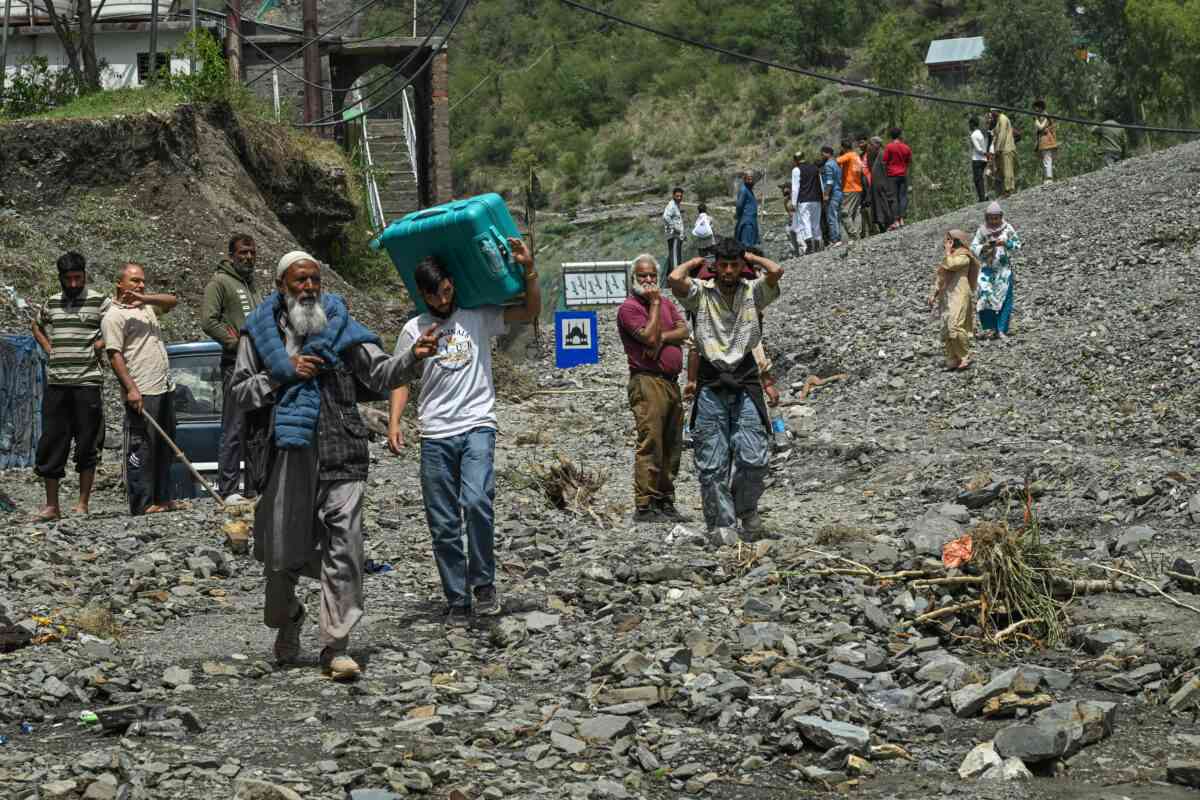On April 19, Bashir Ahmad, a resident of Jammu and Kashmir’s Anantnag district, was carrying a load of 600 apple boxes in his truck when he left from Shopian district. While on his way, heavy rainfall began to lash the region, forcing the closure of roads. Bashir parked his truck near Ramban town, hoping to resume his journey once the weather cleared.
However, on the intervening night of April 19 and 20, landslides triggered by incessant rains struck the region. “My fellow driver and I were sleeping in the truck when we heard a loud rumbling noise – landslides and stones crashing down from the mountains,” he said. “We immediately ran to a safer place.”
When daylight broke the next morning, Bashir was distraught to find his truck buried under debris. “The truck along with the apples was completely damaged,” he said. The truck, valued at around Rs 20 lakh, was carrying apples worth Rs 5 lakh scheduled for delivery in Delhi. Bashir’s story is just one among hundreds affected by the massive natural calamity that struck the hilly district of Ramban.
On April 19 and 20, heavy rainfall, hailstorms, and cloudbursts triggered flash floods that wreaked havoc across the district, particularly affecting the Ramban town and its surrounding villages. The flash floods caused widespread destruction, particularly to a 10 kilometre stretch of the vital Srinagar-Jammu National Highway, cutting off traffic movement for days.
According to the India Meteorological Department, Ramban district received over 117 millimetres of rainfall between April 19 and the morning of April 21, with the heaviest downpour recorded during the intervening night of April 19-20.

Widespread destruction
Brijesh Kumar, a resident of Ramban, vividly recalled the terrifying night. “It felt like there was a massive explosion around 3 am during the intervening night of April 19-20,” he said. “Mud and rocks came crashing down from the mountains, blocking the highway and burying dozens of vehicles. Hundreds of homes were damaged, and many were completely washed away.”
Another local, Ravi Kumar, spoke of his personal tragedy. “Both my shops were swept away by the flash floods,” he said. “I lost my entire livelihood in just one night.”
The devastation left residents in shock, struggling to comprehend the scale of destruction.
Ramban legislator Arjun Singh told Mongabay India that 80% of the town had been affected. “We have never seen such devastation in our lives,” he added. “Many villages were left without electricity or mobile connectivity for days. Several areas remained inaccessible due to debris and damaged roads.”
Preliminary figures of the government reveal the staggering scale of the damage. Three people died and nearly 10,000 livestock – including sheep, goats, and cattle – were killed. At least 109 residential homes were completely destroyed, while 227 others suffered partial damage.
A total of 67 commercial structures, including shops, business establishments, and hotels, were fully damaged, and 78 others sustained partial damage. The floods also destroyed 96 private vehicles and 126 commercial vehicles.

Additionally, over 3,000 vehicles were stranded along the Srinagar-Jammu National Highway for several days due to landslides and avalanches. Jammu and Kashmir Chief Minister Omar Abdullah visited the areas and assured proper rehabilitation and compensation to victims.
Director of the Meteorological Department Kashmir, Mukhtar Ahmad, said that they had issued an advisory warning of a western disturbance impacting Jammu and Kashmir from April 18. “We had already advised that inclement weather could lead to a rise in water levels in rivers, streams, and nallahs – and unfortunately, that is what happened,” he said.
According to a Jammu & Kashmir State Disaster Management Authority report, the Union Territory has long been vulnerable to both natural and human-induced disasters due to its peculiar topography, rugged terrain, extreme weather conditions, and underdeveloped infrastructure.
“Hazards such as earthquakes, flash floods, fires, droughts, avalanches, and landslides frequently result in the loss of human lives and extensive damage to public and private property,” the report says.

Construction, human activity
Experts believe that the scale of the recent disaster was worsened by human activities, particularly unplanned construction and infrastructure development.
Yudhbir Singh, a geologist at the University of Jammu, pointed to a combination of natural and human-induced factors behind the devastation. “It was undoubtedly a natural calamity, but the magnitude of the damage was amplified by human interference,” he said. “We have witnessed a tremendous surge in construction activities, including road development and private infrastructure projects.”
He explained that many natural water channels in the region have been blocked by construction. “When rainfall occurs and these channels are blocked, there is no path for the water to flow,” he told Mongabay India. “As a result, water levels rise uncontrollably, flooding villages and triggering flash floods. There are several places where buildings have been raised directly on old water channels, blocking the natural drainage paths.”
He further stressed the urgent need for comprehensive planning, including the construction of concrete embankments along rivers and the proper diversion of floodwaters. “Without proper flood channel management, we are inviting future disasters,” he said, pointing out that the construction of the four-lane highway had further increased vulnerabilities. “At several places, debris from mountain excavation was simply dumped to construct roads over it. These makeshift foundations are prone to collapse during heavy rains, triggering landslides.”
Citing an example, he noted that in one area where a landslide had occurred years ago, people built houses over the unstable land, resulting in a land-sinking incident last year. “Blasting and drilling during construction have also weakened the soil in several areas,” he added.

Another geologist, SK Pandita of Jammu University, said that while the construction of tunnels on the highway was largely carried out using drilling and boring, with minimal use of blasting, the problem lay elsewhere. “Massive damage occurred due to the construction of hotels, houses, and shops without proper planning,” Pandita said. “When we block natural drainage systems, where will the water go during rainfall? The water naturally overflows into settlements.”
He added that while the recent disaster was triggered by rainfall and a cloudburst, the lack of proper drainage infrastructure turned what could have been a manageable event into a catastrophe.
Mohammad Rafi, a researcher, said the recent tragedy in Ramban serves as a wake-up call for the region. “While natural factors like heavy rainfall and cloudbursts are inevitable, proper urban planning, strict regulations on construction, preservation of natural drainage systems, and scientific road development are crucial to minimising the impact of such disasters,” he said.
He also pointed out that there are many hydro power projects in the area. “If there are flash floods, the dams could also burst at any time,” he added. “We need proper planning to meet any eventuality in the future.”
This article was first published on Mongabay.










